

The crayola-fication of the world: How we gave colors names, and it messed with our brains (part I) “Who in the rainbow can draw the line where the violet tint ends and the orange tint begins?
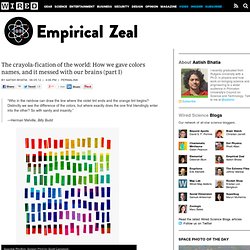
Distinctly we see the difference of the colors, but where exactly does the one first blendingly enter into the other? So with sanity and insanity.” —Herman Melville, Billy Budd Spectral Rhythm. Screen Print by Scott Campbell. In Japan, people often refer to traffic lights as being blue in color. Blue and green are similar in hue. One of the first fences in this color continuum came from an unlikely place – crayons. Reconstructing the rainbow. In modern Japanese, midori is the word for green, as distinct from blue.
And it’s not just Japanese. (Update: Some clarifications here. I find this fascinating, because it highlights a powerful idea about how we might see the world. Color Survey Results. Who in the rainbow can draw the line where the violet tint ends and the orange tint begins?

Distinctly we see the difference of the colors, but where exactly does the one first blendingly enter into the other? So with sanity and insanity. —Herman Melville, Billy Budd Orange, red? I don’t know what to believe anymore! I WILL EAT YOUR HEART WITH A FUCKING SPOON IF YOU AKS ANY MORE QUESTIONS ABOUT COLORS —Anonymous, Color Survey.
The crayola-fication of the world: How we gave colors names, and it messed with our brains (part II) Untitled (Cubes) by Scott Taylor Update: This post was an Editor’s pick by Cristy Gelling at Science Seeker, and was included in Bora Zivkovic‘s top 10 science blog posts of the week.
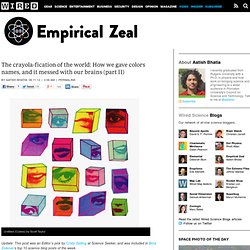
Lately, I’ve got colors on the brain. List of colors. The following is a list of colors.
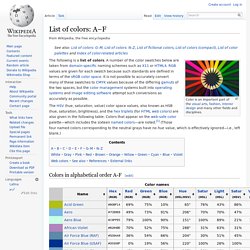
A number of the color swatches below are taken from domain-specific naming schemes such as X11 or HTML4. RGB values are given for each swatch because such standards are defined in terms of the sRGB color space. It is not possible to accurately convert many of these swatches to CMYK values because of the differing gamuts of the two spaces, but the color management systems built into operating systems and image editing software attempt such conversions as accurately as possible. Colors / Puce. “Colors” is a column in which a writer responds to a specific color assigned by the editors of Cabinet.

Adolphe Neyt, photomicrograph of a flea, ca. 1865. A nomenclature of colors for naturalists : and compendium of useful knowledge for ornithologists. : Ridgway, Robert, 1850-1929. Juventus mundi: the gods and men of the heroic age - William Ewart Gladstone. Ancient Greek Color Vision. M/C Journal. "The eye altering, alters all.
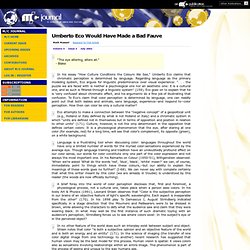
" - Blake 2In his essay "How Culture Conditions the Colours We See," Umberto Eco claims that chromatic perception is determined by language. Regarding language as the primary modeling system, Eco argues for linguistic predominance over visual experience: ". . . the puzzle we are faced with is neither a psychological one nor an aesthetic one: it is a cultural one, and as such is filtered through a linguistic system" (159). Eco goes on to explain that he is 'very confused' about chromatic effect, and his arguments do a fine job of illustrating that confusion. 3Eco attempts to make a connection between the "negative concept" of a geopolitical unit (e.g., Holland or Italy defined by what is not Holland or Italy) and a chromatic system in which "units are defined not in themselves but in terms of opposition and position in relation to other units" (171). 6In no other feature of the world does such an interplay exist between subject and object.
NAMING THE RAINBOW : COLOUR LANGUAGE, COLOUR SCIENCE, AND CULTURE (Volume 274, Synthese Library, Kluwer Academic Publishers, 19. Naming the rainbow : colour language, colour science, and culture (Volume 274, Synthese Library, Kluwer Academic Publishers, 1998) In the middle of the 19th century William Gladstone, classicist and Prime-Minister, argued that Homeric Greeks perceived colour differently from contemporary Europeans.
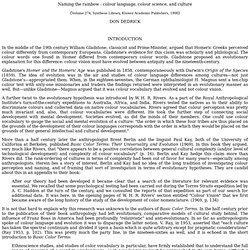
Gladstone's evidence for this claim was scholarly and philological. The colour words one found in Homer differed from contemporary colour words. Colour words in many languages. This section contains the colour words that have been indentified in various studies as the most common across most languages, although the actual colours represented by each of the colour words are not nescessarily exactly the same.

Media_183218_en. Latin Color Bibliography. Are Color Distinctions Natural or Culturally Created? More on Language and How We See the World. I recently wrote briefly (it was during my 1200 word limit period) about Guy Deutscher's book Through the Language Glass: Why The World Looks Different in Other Languages In it, he's taking on the dominant linguistic paradigm (and Noam Chomsky) which argues that humans are genetically wired for language, all languages come from the same basic blueprint, and thus language does not affect how people think.

Deutscher thinks it does. The first part of the book was really interesting - it's about colors and whether they are 'natural' or 'culturally dependent.' So I'm going to get into this a bit more deeply than I do with most books. But remember, I'm just hitting the highlights, there are a lot more details that fill in the gaps in the book. [I'd note this is also a great topic to put into your mental notes about how people know what they know - a basic theme of this blog.] In 1898, W.H.R. This was a 'big win' for the culturalists. Except, 20 language groups aren't very many. 4175133. Why do cultures always name red before they do blue? Major omission here.
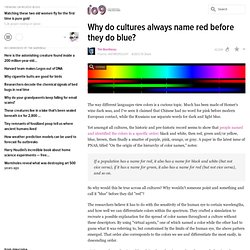
This all dates from Berlin and Kay's book, Basic Color Terms, from 1969. In a nutshell: they were linguists and posited that there was some kind of universal rule of linguistic creation of color terms. They did the research by interviewing over 100 native speakers of different languages, and recorded what color terms those languages indigenously had (in other words, they excluded loan words from other languages, words that were used for colors but really referred to specific things like the color "peach", and words that were recognized as a subset of a basic term, like "royal blue", a subset of blue). They brought along a spectrum of colors so people could point to the most quintessential example of what the word was referring to.
They found that there was a specific order of color adoption. All the colors of the rainbow (and beyond)… To continue with our theme of lexical divergencies, let’s consider color terms. It has been long known that languages differ as to which colors and even how many they choose to encode with basic color terms. To be considered basic, a color term must be: (1) monoleximic (have one lexeme, often one morpheme; e.g., green but not dark green or olive green), (2) frequent in use and (3) acquired early by children.
Speakers of a language typically agree as to what constitutes basic color terms in that language. The color wheel below represents six basic rainbow color terms in English: red, orange, yellow, green, blue and violet (red-orange, orange-yellow, yellow-green, green-blue, blue-violet and violet-red are not basic color terms). Further basic color terms that may be added to the lexicon are (in any order): ‘brown’, ‘orange’, ‘pink’, ‘purple’ and/or ‘gray’. Similarly, languages vary as to which hues are split into different colors on the basis of how light or dark they are. Grue? Bleen? Rellow? In the previous posting, I mentioned the concept of “grue”, a color that extends to include both shades of green and shades of blue.
The term itself is a blend of “green” and “blue” (I personally prefer the term “bleen”, due to my cousin Benny, but linguists and anthropologists tend to use the term “grue”). What is exactly this “grue”? Some (better known) languages, such as English, French, Spanish, German, Russian and Japanese, have separate basic color terms for the two “cool primaries” — blue and green. Hanunoo Color Categories. Harvard sociobiologist E.O. Wilson on the origins of the arts.